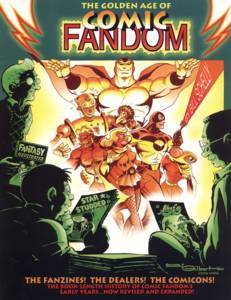

| Click on a book's image or title to order from Amazon.com |

The Golden Age of Comic Fandom
by Bill SchellyHamster Press, © 1995, ISBN #0-9645669-7
Schelly has put together a truly remarkable piece of work, covering the rise of comic book fandom from 1960-1972. He begins by summarizing fandom (such as it was) in the 1940s and 50s - it was mainly a rather looked-down-upon subset of science fiction fandom - and then launches into the rise of the fanzines and comicons in the 60s.
What I think is really remarkable to me is how insular a hobby comic books were in 1960. While science fiction fandom arose fairly quickly after a critical mass of creators and hobbyists were established, comics as an industry had already gone through a major boom-then-bust-then-boom-again cycle before comics fandom was established. People really did have whole attics of old comics lying around, because there was no market for them. It was unusual, in 1960, for any comic published after 1942 to cost more than $2.00.
While there were a few comics fans publishing fanzines in SF fandom in 1960 (most notably Dick and Pat Lupoff and Don and Maggie Thompson - Dick and Don eventually published a book of essays on 40s comics entitled All In Color For A Dime, which is quite neat), it was college professor Jerry Bails of Michigan who started the fanzine Alter Ego and actively sought out fans through comic book letter columns. He established the first fanzine intended solely for the purpose of trading comics, and was instrumental (in the late 60s) in the publication of the first standard price guide (Bob Overstreet's).
Fandom took off after Alter Ego was published in 1961, and by 1965 comic conventions were being held, and there was a wide range of amateur fanzines with amateur comic strips in them. Many individuals moved from fandom into professional comics (Roy Thomas is famous for having done this). Julie Schwartz and Stan Lee both were very encouraging of fandom early in its existence - Schwartz because he'd been a longtime SF fan, and Lee perhaps because he recognized the built-in marketing potential it held for the then-fledgling Marvel Comics superhero revival.
The book focuses, by-and-large, on fanzine fandom, since in the 60s that's a huge chunk of what fandom was. It discusses fanzines, personalities, the effort to collect and exchange information, the founding of CAPA-Alpha (which recently celebrated its 30th anniversary as the longest-standing comics APA), and the fans' first attempts to get together in informal gatherings and in conventions. It details the rise of bookstores with sections dedicated to old comics (the direct market would not come into existence until 1974). By the late 60s it begins to focus on "pro-zines", where established creators (e.g., Wally Wood) circulated and sold copies of unused material from their personal files.
There are some other notable highlights as well: The influence of the 60s counterculture on comics fandom (more pervasive than in the comics themselves); Dr. Sol Davidson, who in the mid-sixties wrote his Ph.D. dissertation on comic strips and books; the emergence of fans who perceived the potential of comics as a form of real literature, and the coining of the term "graphic novel"; and the founding of the San Diego Comicon (which apparently would not have gotten off the ground without the magnanimous help of Forrest J. Ackerman).
Some interesting names pop up, too: G.B. Love was a major part of 60s fandom; today he co-edits the Best of Trek paperbacks. Gary Groth, who grew up in the 60s, published a fanzine in the late 60s (there is a photo of him when he was 15). And even a 1973 publication by none other than Dr. Frederick Wertham on fandom, entitled The World of Fanzines, which concluded (rather pompously) that "the editing of fanzines is a constructive and healthy exercise of creative drives. Fanzines are a healthy part of our society."
It's certainly a fascinating book for any longtime comics fan. Unfortunately, Schelly seems to have decided to publish only 1000 copies, and see how they sold (I have #742). Hopefully he'll reprint it. Otherwise, you can try to get a copy from Bud Plant Comic Art, or by writing to Schelly c/o Hamster Press, PO Box 27471, Seattle, WA, 98125. The book cost me $11.95.
hits since 13 August 2000.